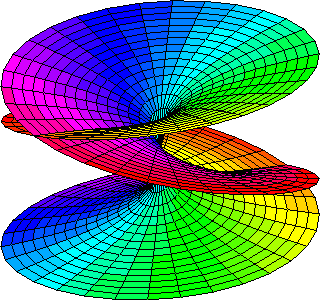
MATH 431 Algebraic Geometry
Preliminary Notes
by
Ali Sinan Sertöz
January
2011
Mathematics can be described, in the most naive sense, as the art of making significant definitions and then attempting to classify all instances of that definition.
Generally we make a definition out of sheer curiosity.
For example, what happens if we define an infinite dimensional vector space and put some inner product structure on it? This leads eventually to a better understanding of function spaces, solutions of differential equations and, most surprising of all, quantum mechanics.
Or, consider what happens if we concentrate on the distance function and try to understand spaces through this local-to-global approach. This eventually leads to a revolutionary development in geometry and finds unexpected and certainly unintended applications in relativity theory.
For that matter, what happens if we start defining classical geometric objects in a totally different way? Classically, conic sections are defined as the intersection of a cone with a plane perpendicular to a generator of the cone. Translating this to Cartesian coordinates, we see that a conic section is the set of points in the plane where a polynomial equation of degree two in the plane variables x and y vanish.
Now let us make a giant and courageous generalization and agree that geometry will study the set of points where a collection of polynomials each vanish. This of course should happen not necessarily in the plane but in n-space.
Does this lead to any meaningful theory?
It leads to Algebraic Geometry. I quote from Wikipedia:
Algebraic geometry is a branch of mathematics which combines techniques of abstract algebra, especially commutative algebra, with the language and the problems of geometry. It occupies a central place in modern mathematics and has multiple conceptual connections with such diverse fields as complex analysis, topology and number theory. Initially a study of polynomial equations in many variables, the subject of algebraic geometry starts where equation solving leaves off, and it becomes at least as important to understand the totality of solutions of a system of equations, as to find some solution; this leads into some of the deepest waters in the whole of mathematics, both conceptually and in terms of technique.
Does this apply anywhere? I again quote from Wikipedia:
Algebraic geometry now finds application in statistics, control theory, robotics, error-correcting codes, phylogenetics and geometric modeling. There are also connections to string theory, game theory, graph matchings, solitons and integer programming. Google scholar lists hundreds of more studies on algebraic geometry in biology, chemistry, economics, physics and of course other areas of mathematics. Recent work has suggested that algebraic geometry may be the key to solving the famous P vs NP problem.
For example, one of the crown theorems of Algebraic Geometry, the Riemann-Roch theorem, is applied in coding theory to actually construct good codes. We will study the meaning and implications of the Riemann-Roch theorem in the classification problem of curves from a purely geometric approach.
We will study the complex curves which form the foundational and probably the most exciting part of Algebraic Geometry. The ideas developed here are essential in guessing and discovering results in higher dimensions.
The lead character of the course is the concept of divisors, a few points with some numbers attached to them, on a curve. And the main adventure of this hero is the Riemann-Roch Theorem.
Bernhard Riemann first proved this theorem as an inequality and later Gustav Roch proved the equality in 1865. (Both died of tuberculosis in Italy at the ages of 42 and 26 respectively.)
This theorem, which is next to a miracle, counts the dimension of the space of acceptable functions on the curve in terms of the usual invariants and the number of points you considered as a divisor. It is then a big surprise to see that this tiny information leads to shocking consequences. (Curve theory is full of miracles, shocking results and surprises. It is a lesson in modesty for human kind in the face of the supreme order of things in nature.)
It took mankind almost a century to even write down and then prove a reasonable version of this theorem for higher dimensions.
This was eventually achieved by Friedrich Hirzebruch. The Hirzebruch-Riemann-Roch theorem in turn was instrumental for the proof of Atiyah-Singer index theorem which generalizes it and has far reaching applications, including but is not restricted to theoretical physics.
By this time you must have started to guess, and correctly so, that in this course we will only touch the water at the shore of an ocean. Feel the breeze, hear the seducing roar of the ocean and dive! You will be in good company.

Contact address is: